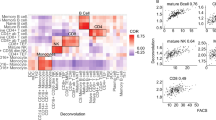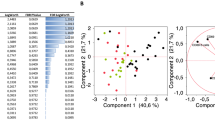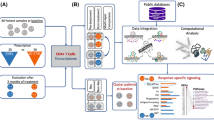Abstract
To provide insight into the pharmacological changes in the peripheral blood (PB) molecular profile induced by tumor necrosis factor (TNF)-blockade in patients with rheumatoid arthritis (RA), blood was obtained in PAXgene tubes from 33 RA patients before and 1 month after TNF-blocking therapy (infliximab). From 15 randomly chosen patients pre- and post-treatment gene expression profiles were determined. The remaining 18 RA patients served as validation cohort. A group-based paired analysis of the gene expression profiles from the post- vs pre-treatment samples revealed a signature of genes significantly regulated by TNF-blockade. Downregulated genes reflected several biological pathways such as inflammation, angiogenesis, B- and T-cell activation. Further analysis revealed that the pharmacological response signature was significantly regulated in all treated patients, irrespective of clinical response, which is indicative for the presence of an active TNF pathway in all RA patients. The data imply that all patients carried features of TNF bioactivity irrespective of clinical response. These results favor a model for the parallel presence of TNF-dependent and TNF-independent pathways in the individual RA patient. Clinical response status to TNF-blockade may be dependent on the relative contribution of TNF-independent effector pathways.
This is a preview of subscription content, access via your institution
Access options
Subscribe to this journal
Receive 6 digital issues and online access to articles
$119.00 per year
only $19.83 per issue
Buy this article
- Purchase on Springer Link
- Instant access to full article PDF
Prices may be subject to local taxes which are calculated during checkout



Similar content being viewed by others
References
Feldmann M, Brennan FM, Maini RN . Rheumatoid arthritis. Cell 1996; 85: 307–310.
Elliott MJ, Maini RN, Feldmann M, Kalden JR, Antoni C, Smolen JS et al. Randomised double-blind comparison of chimeric monoclonal antibody to tumour necrosis factor alpha (cA2) versus placebo in rheumatoid arthritis. Lancet 1994; 344: 1105–1110.
Feldmann M, Maini RN . Anti-TNF alpha therapy of rheumatoid arthritis: what have we learned? Annu Rev Immunol 2001; 19: 163–196.
Tracey D, Klareskog L, Sasso EH, Salfeld JG, Tak PP . Tumor necrosis factor antagonist mechanisms of action: a comprehensive review. Pharmacol Ther 2008; 117: 244–279.
Marotte H, Maslinski W, Miossec P . Circulating tumour necrosis factor-alpha bioactivity in rheumatoid arthritis patients treated with infliximab: link to clinical response. Arthritis Res Ther 2005; 7: R149–R155.
Wijbrandts CA, Dijkgraaf MG, Kraan MC, Vinkenoog M, Smeets TJ, Dinant H et al. The clinical response to infliximab in rheumatoid arthritis is in part dependent on pretreatment tumour necrosis factor alpha expression in the synovium. Ann Rheum Dis 2008; 67: 1139–1144.
Grell M, Wajant H, Zimmermann G, Scheurich P . The type 1 receptor (CD120a) is the high-affinity receptor for soluble tumor necrosis factor. Proc Natl Acad Sci USA 1998; 95: 570–575.
Grell M, Douni E, Wajant H, Lohden M, Clauss M, Maxeiner B et al. The transmembrane form of tumor necrosis factor is the prime activating ligand of the 80 kDa tumor necrosis factor receptor. Cell 1995; 83: 793–802.
Pocsik E, Duda E, Wallach D . Phosphorylation of the 26 kDa TNF precursor in monocytic cells and in transfected HeLa cells. J Inflamm 1995; 45: 152–160.
Danhof M, de Lange EC, la Pasqua OE, Ploeger BA, Voskuyl RA . Mechanism-based pharmacokinetic-pharmacodynamic (PK-PD) modeling in translational drug research. Trends Pharmacol Sci 2008; 29: 186–191.
Workman P . How much gets there and what does it do?: the need for better pharmacokinetic and pharmacodynamic endpoints in contemporary drug discovery and development. Curr Pharm Des 2003; 9: 891–902.
Charles P, Elliott MJ, Davis D, Potter A, Kalden JR, Antoni C et al. Regulation of cytokines, cytokine inhibitors, and acute-phase proteins following anti-TNF-alpha therapy in rheumatoid arthritis. J Immunol 1999; 163: 1521–1528.
Koczan D, Drynda S, Hecker M, Drynda A, Guthke R, Kekow J et al. Molecular discrimination of responders and nonresponders to anti-TNFalpha therapy in rheumatoid arthritis by etanercept. Arthritis Res Ther 2008; 10: R50.
Lequerre T, Gauthier-Jauneau AC, Bansard C, Derambure C, Hiron M, Vittecoq O et al. Gene profiling in white blood cells predicts infliximab responsiveness in rheumatoid arthritis. Arthritis Res Ther 2006; 8: R105.
Lindberg J, af Klint E, Catrina AI, Nilsson P, Klareskog L, Ulfgren AK et al. Effect of infliximab on mRNA expression profiles in synovial tissue of rheumatoid arthritis patients. Arthritis Res Ther 2006; 8: R179.
van der Pouw Kraan TC, Wijbrandts CA, van Baarsen LG, Rustenburg F, Baggen JM, Verweij CL et al. Responsiveness to anti-TNF{alpha} therapy is related to pre-treatment tissue inflammation levels in Rheumatoid Arthritis patients. Ann Rheum Dis 2008; 67: 563–566.
de Vries N, Tak PP . The response to anti-TNF-alpha treatment: gene regulation at the bedside. Rheumatology (Oxford) 2005; 44: 705–707.
McInnes IB, Schett G . Cytokines in the pathogenesis of rheumatoid arthritis. Nat Rev Immunol 2007; 7: 429–442.
Miossec P . Cytokines in rheumatoid arthritis: is it all TNF-alpha? Cell Mol Biol (Noisy-le-grand) 2001; 47: 675–678.
Smolen JS, Han C, Bala M, Maini RN, Kalden JR, van der HD et al. Evidence of radiographic benefit of treatment with infliximab plus methotrexate in rheumatoid arthritis patients who had no clinical improvement: a detailed subanalysis of data from the anti-tumor necrosis factor trial in rheumatoid arthritis with concomitant therapy study. Arthritis Rheum 2005; 52: 1020–1030.
Pincus T, Yazici Y, Yazici H, Kavanaugh AF, Kremer JM, Wolfe F . Radiographic benefit without clinical improvement in infliximab-treated patients with rheumatoid arthritis: comment on the article by Smolen et al. Arthritis Rheum 2005; 52: 4044–4045.
van den Berg WB, van Riel PL . Uncoupling of inflammation and destruction in rheumatoid arthritis: myth or reality? Arthritis Rheum 2005; 52: 995–999.
Pachot A, Arnaud B, Marrote H, Cazalis MA, Diasparra J, Gouraud A et al. Increased tumor necrosis factor-alpha mRNA expression in whole blood from patients with rheumatoid arthritis: reduction after infliximab treatment does not predict response. J Rheumatol 2007; 34: 2158–2161.
van Baarsen LG, Wijbrandts CA, Rustenburg F, Cantaert T, van der Pouw Kraan TC, Baeten DL et al. Regulation of IFN response gene activity during infliximab treatment in rheumatoid arthritis is associated with clinical response to treatment. Arthritis Res Ther 2010; 12: R11.
Verweij CL . Predicting the future of anti-tumor necrosis factor therapy. Arthritis Res Ther 2009; 11: 115.
van Gestel AM, Prevoo ML, van ‘t Hof MA, van Rijswijk MH, van de Putte LB, van Riel PL . Development and validation of the European League Against Rheumatism response criteria for rheumatoid arthritis. Comparison with the preliminary American College of Rheumatology and the World Health Organization/International League against Rheumatism Criteria. Arthritis Rheum 1996; 39: 34–40.
Fransen J, van Riel PL . The disease activity score and the EULAR response criteria. Clin Exp Rheumatol 2005; 23: S93–S99.
van Gestel AM, Haagsma CJ, van Riel PL . Validation of rheumatoid arthritis improvement criteria that include simplified joint counts. Arthritis Rheum 1998; 41: 1845–1850.
van der Pouw Kraan TC, Wijbrandts CA, van Baarsen LG, Voskuyl AE, Rustenburg F, Baggen JM et al. Rheumatoid arthritis subtypes identified by genomic profiling of peripheral blood cells: assignment of a type I interferon signature in a subpopulation of patients. Ann Rheum Dis 2007; 66: 1008–1014.
van der Pouw Kraan TC, van Baarsen LG, Rustenburg F, Baltus B, Fero M, Verweij CL . Gene expression profiling in rheumatology. Methods Mol Med 2007; 136: 305–327.
Demeter J, Beauheim C, Gollub J, Hernandez-Boussard T, Jin H, Maier D et al. The Stanford Microarray Database: implementation of new analysis tools and open source release of software. Nucleic Acids Res 2007; 35: D766–D770.
van Baarsen LG, van der Pouw Kraan TC, Kragt JJ, Baggen JM, Rustenburg F, Hooper T et al. A subtype of multiple sclerosis defined by an activated immune defense program. Genes Immun 2006; 7: 522–531.
Tusher VG, Tibshirani RandChu G . Significance analysis of microarrays applied to the ionizing radiation response. Proc Natl Acad Sci USA 2001; 98: 5116–5121.
Eisen MB, Spellman PT, Brown PO, Botstein D . Cluster analysis and display of genome-wide expression patterns. Proc Natl Acad Sci USA 1998; 95: 14863–14868.
Thomas PD, Campbell MJ, Kejariwal A, Mi H, Karlak B, Daverman R et al. PANTHER: a library of protein families and subfamilies indexed by function. Genome Res 2003; 13: 2129–2141.
Thomas PD, Kejariwal A, Guo N, Mi H, Campbell MJ, Muruganujan A et al. Applications for protein sequence-function evolution data: mRNA/protein expression analysis and coding SNP scoring tools. Nucleic Acids Res 2006; 34: W645–W650.
Acknowledgements
This study was supported by a grant from The Netherlands Organization for Health Research and Development (ZonMw) in assignment of The Netherlands Organization for Scientific Research (NWO) (grant number 945-02-029), the European Community's FP6 funding (Autocure), the Innovation Oriented research Program (IOP) on Genomics and the Centre for Medical Systems Biology (The Netherlands Genomics Initiative). This publication reflects only the authors’ views. The European Community is not liable for any use that may be made of the information herein.
Author information
Authors and Affiliations
Corresponding author
Ethics declarations
Competing interests
PP Tak has served as a consultant for Abbott, Amgen, Centocor, Schering-Plough, UCB and Wyeth.
Additional information
Supplementary Information accompanies the paper on Genes and Immunity website
Supplementary information
Rights and permissions
About this article
Cite this article
van Baarsen, L., Wijbrandts, C., Gerlag, D. et al. Pharmacogenomics of infliximab treatment using peripheral blood cells of patients with rheumatoid arthritis. Genes Immun 11, 622–629 (2010). https://doi.org/10.1038/gene.2010.34
Received:
Revised:
Accepted:
Published:
Issue Date:
DOI: https://doi.org/10.1038/gene.2010.34
Keywords
This article is cited by
-
Molecular profiling of rheumatoid arthritis patients reveals an association between innate and adaptive cell populations and response to anti-tumor necrosis factor
Arthritis Research & Therapy (2019)
-
The type I interferon signature in leukocyte subsets from peripheral blood of patients with early arthritis: a major contribution by granulocytes
Arthritis Research & Therapy (2016)
-
Is there a role of synovial biopsy in drug development?
BMC Musculoskeletal Disorders (2016)
-
Developing Peripheral Blood Gene Expression-Based Diagnostic Tests for Coronary Artery Disease: a Review
Journal of Cardiovascular Translational Research (2015)
-
Gene expression analysis in RA: towards personalized medicine
The Pharmacogenomics Journal (2014)



